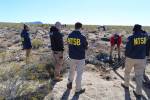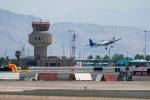F-22 problems foreseen early on
KADENA AIR BASE, Japan - Years before F-22 pilots began getting dizzy in the cockpit, before one struggled to breathe as he tried to pull out of a fatal crash, before two more went on television to say the plane was so unsafe they refused to fly it, a small circle of U.S. Air Force experts knew something was wrong with the stealth fighter.
Coughing among pilots and fears that contaminants were leaking into their breathing apparatus led the experts to suspect flaws in the oxygen-supply system of the F-22 Raptor, especially in extreme high-altitude conditions in which the $190 million aircraft is without equal. They formed a working group a decade ago to deal with the problem .
Internal documents and emails show they proposed a range of solutions by 2005, including adjusting the flow of oxygen into pilot's masks. But that recommendation was rejected by officials reluctant to add costs to a program already well over budget.
PowerPoint presentations, minutes of meetings and emails reveal a missed opportunity to improve pilot safety in the 187-plane F-22 fleet before a series of problems damaged the image of an aircraft that was already assailed in Congress as too costly. Its production was halted last spring, and the aircraft has never been used in combat.
Among problems reported after the working group's warnings:
■ In 2008, pilots began reporting a sharp increase in hypoxia-like problems, forcing Air Force officials to acknowledge concerns about the F-22's oxygen supply system.
■ Two years later, the oxygen system contributed to a fatal crash. Pilot error was blamed, but the fleet was grounded for four months in 2011.
■ New restrictions were imposed in May, after two pilots on the CBS program "60 Minutes" to expressed misgivings.
Air Force officials say the F-22 is safe to fly. A dozen began a six-month deployment to Japan in July. But flight restrictions prevent high-altitude situations where breathing is most stressed.
Fifteen Raptors are assigned to Nellis Air Force Base . They are flown by the 422nd Test and Evaluation Squadron and the 433rd Weapons Squadron.
Raptor pilots from six bases, including Nellis, were among those investigators think were exposed to toxins or conditions in the aircraft's life-support system that reduced blood oxygen levels during flight. The pilots' concerns spurred Air Force officials to look at everything from hoses, masks and anti-G force garments to top secret coatings and adhesives used in the plane's radar-evading stealth skin.
One of the working group's proposed fixes, a backup oxygen system, is expected to be in place by year's end. And the Air Force reports a fix for a faulty valve in the pilots' vests is also coming.
The working group also proposed changes in warning systems to alert pilots to system failures and urged enhanced tracking of potential health hazards caused by materials used to bolster the aircraft's stealth. Those were two more issues Air Force investigations would later focus on.
Air Force officials concede that while they were tackling the F-22's issues, they were too aggressive in cutting back on life-support programs intended to ensure pilot safety.
The F-22's gradual return to regular flight operations follows an investigation over the past year by the Air Force, NASA, experts from Lockheed Martin, which produces the aircraft, and other industry officials.
But documents show many of the concerns raised in that investigation already had been outlined by the working group formed in 2002, when the fighter was still in its early production and delivery stage.
It called itself RAW-G, for Raptor Aeromedical Working Group, and brought together dozens of experts in life support, avionics, physiology and systems safety, with F-22 air crew members and maintenance techs.
The group was founded by members of the F-22 community who were concerned about how the demands of the aircraft could affect pilots. The fighter can evade radar and fly faster than sound without using afterburners, capabilities unmatched by any other country. It also flies higher than its predecessors and has a self-contained oxygen generation system to protect pilots from chemical or biological attack.
By the time RAW-G got going, some pilots were already experiencing "Raptor cough," fits of chest pain and coughing that stem from collapse of overworked air sacs in the lungs.
The group concluded the F-22's On-Board Oxygen Generation System was giving pilots too much oxygen, causing the coughing. The more often and higher the pilots flew after being oxygen-saturated, the more vulnerable pilots affected by the condition would be to other physiological incidents.
The working group recommended more tests, adjustment of the oxygen delivery system through a digital controller and a software upgrade. The group spent two years pushing for the change in the amount of oxygen pumped into life-support systems, but the software upgrade never happened.
"The cost was considered prohibitive in light of other items that people wanted funded for the F-22," said Kevin Divers, a former Air Force physiologist who spearheaded RAW-G until he left the service in 2007 and the group disbanded.
Divers thinks the cost would have been about $100,000 per aircraft.
The link between oxygen saturation at lower altitudes and a spate of hypoxia-like incidents at high altitudes remains a matter of debate . Both the Air Force and the NASA, however, now concur that the F-22's oxygen schedule needs to be revised.























